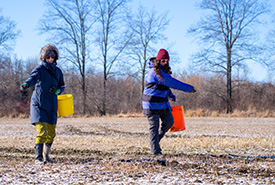Visit our blogger resource page.
A Labour of Love: National Volunteer Week

Seeding at Brighton Wetland, ON (Photo by Chelsea Marcantonio/NCC Staff)
A thank you to volunteers in Central Ontario East for their hard work sowing native plant species on NCC's Brighton Wetland property on February 14, 2024.
Show me the spreadsheet: Unveiling the wonders of working landscapes

NCC Stewardship Coordinator, Casey Rempel, engaging with Aberdeen Pasture patrons during a field event. (Photo by Matthew Braun/NCC staff)
What crazy jobs we have. Did you think when you were a young student that shuffling numbers on a spreadsheet for a school project would be the key bit of experience you’d need for conservation? Yeah, me neither. Let me explain by going on a...
High notes in the bur oaks: Songs of the Manitoulin savanna

Manitoulin Island, ON (Photo by Steve Maxwell)
A bouncing ping-pong ball, buzzes, bugles and booms: these are the sounds of the savanna. For someone unaware, the symphony of bur oak savanna on Ontario’s Manitoulin Island may seem unfamiliar. For many species of grassland birds, however,...
Twelve Mile Creek: Niagara’s last remaining cold-water habitat

View of lower pond and adjacent embankment crest at Lathrop Nature Preserve, ON (Photo by Noel Boucher/ NCC)
In the urban landscape of Niagara, Ontario, lies a hidden gem: Twelve Mile Creek. This stream holds significant importance as the last remaining cold-water habitat in the region, serving as a critical lifeline for native species, including brook...
Gardening: Small choices make a big difference

Megachile (leafcutter, mortar, and resin) bee on swamp milkweed (Photo by Sarah Ludlow)
Well, it is that time of year again — when the hope of spring and warmer temperatures is edging ever closer, especially in my home province of Saskatchewan. It is also the time when I begin starting my seeds to plant in my garden this...
Spotting the spotted wintergreen: Research on rare woodland plants in Ontario

A tagged spotted wintergreen plant (Photo by Amy Wiedenfeld/NCC staff)
As summer approaches, I look forward to getting out into the field. This includes visiting many of the spotted wintergreen populations in Ontario for my PhD research, supported by the Weston Family Conservation Science Fellowship Program. Spotted...

